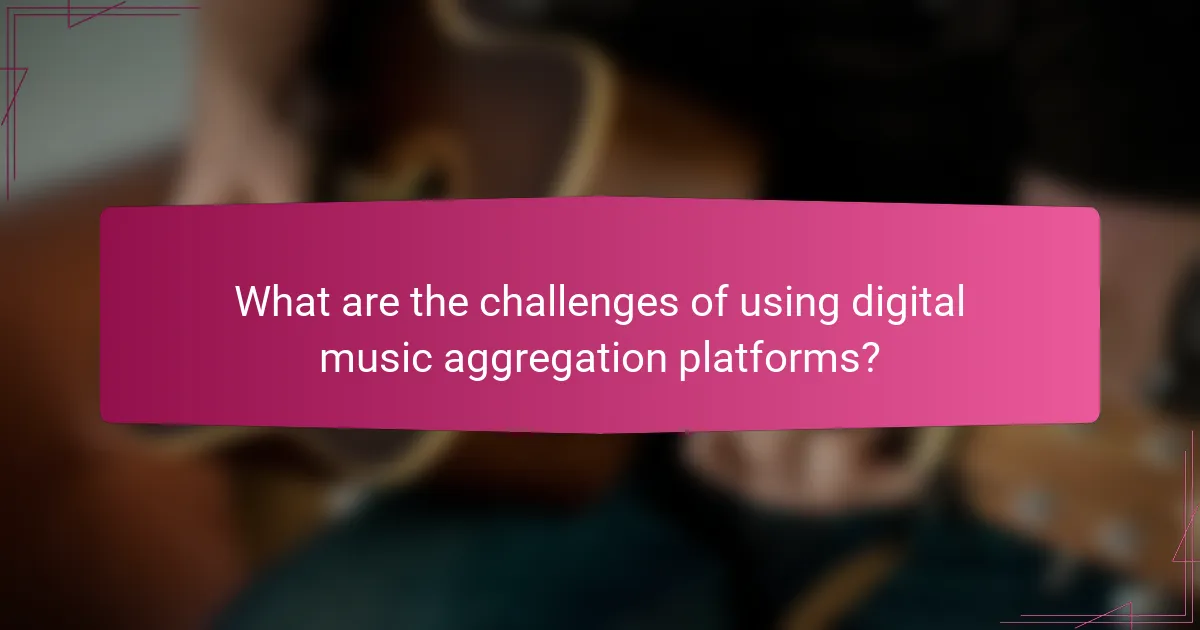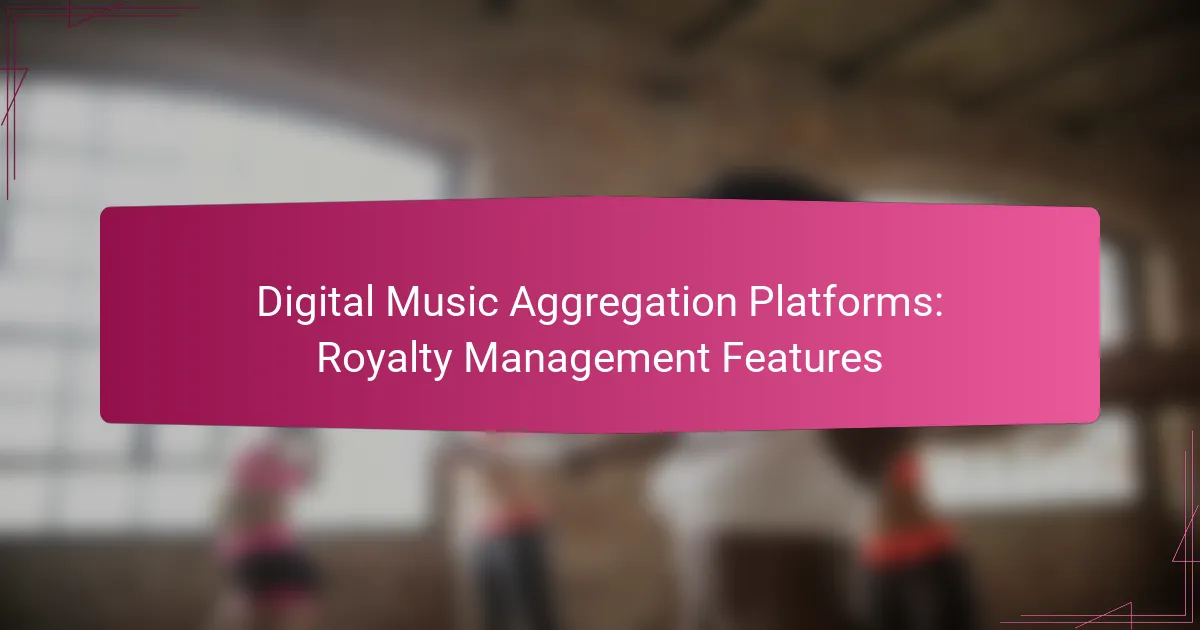Digital music aggregation platforms play a crucial role in royalty management by automating the collection and distribution of earnings for artists. With features designed to track earnings, manage rights, and ensure fair compensation, these platforms enhance transparency and streamline the payment process across various music streaming services. Selecting the right system is essential for maximizing revenue and gaining insights into music performance.

What are the best digital music aggregation platforms for royalty management?
The best digital music aggregation platforms for royalty management streamline the process of collecting and distributing royalties to artists. These platforms offer various features that help musicians track earnings, manage rights, and ensure they receive fair compensation for their work.
DistroKid
DistroKid is known for its user-friendly interface and fast royalty payments, often processing earnings within a week. It allows artists to upload unlimited tracks for a flat annual fee, making it cost-effective for those releasing multiple songs or albums.
Key features include automatic royalty splitting among collaborators and the ability to distribute music to a wide range of streaming services. However, artists should be aware that DistroKid does not offer traditional customer support, relying instead on a comprehensive FAQ section.
CD Baby
CD Baby provides a robust platform for independent musicians, offering both digital and physical distribution options. Artists pay a one-time fee per release, which can be beneficial for those who prefer not to commit to an annual subscription.
The platform features detailed royalty tracking and offers additional services like sync licensing and music publishing. However, the upfront costs can add up, especially for multiple releases, so artists should weigh their options carefully.
TuneCore
TuneCore is another popular choice, known for its extensive distribution network and transparent royalty reporting. Artists pay an annual fee for each release, which allows them to keep 100% of their earnings.
Its dashboard provides insights into sales and streaming data, helping artists make informed decisions. However, the annual fees can become a burden for those with a limited number of releases, so it’s essential to consider long-term plans.
Amuse
Amuse offers a unique approach by providing a free distribution service with optional premium features. Artists can release music without upfront costs, making it an attractive option for newcomers.
However, the free version has limitations on the number of releases and features available. For those seeking more advanced tools, Amuse Pro offers additional services for a monthly fee, allowing for greater flexibility in royalty management.
LANDR
LANDR combines music distribution with mastering services, making it a convenient choice for artists looking to enhance their sound. The platform offers a subscription model that allows for unlimited releases and includes royalty tracking features.
While LANDR is appealing for its all-in-one approach, artists should consider the quality of mastering services and whether they align with their specific needs. Additionally, the subscription cost may not be ideal for those with fewer releases.

How do digital music aggregation platforms manage royalties?
Digital music aggregation platforms manage royalties by automating the tracking, reporting, and distribution of earnings from music streams and downloads. These systems ensure that artists receive accurate payments based on their music’s performance across various platforms.
Automated royalty tracking
Automated royalty tracking systems monitor music usage across streaming services, downloads, and radio plays. These platforms collect data on how often a track is played, which helps in calculating the royalties owed to artists. By utilizing advanced algorithms and data analytics, they can provide precise tracking with minimal manual input.
Many platforms integrate with major music services like Spotify, Apple Music, and YouTube, allowing for seamless data collection. This automation reduces the risk of human error and ensures timely updates on earnings.
Real-time reporting
Real-time reporting features provide artists and rights holders with immediate access to their earnings data. This transparency allows musicians to track their income as it accumulates, rather than waiting for periodic statements. Such features often include dashboards that visualize earnings trends and performance metrics.
With real-time insights, artists can make informed decisions about marketing and promotional strategies. Many platforms offer customizable reports, enabling users to focus on specific time frames or revenue sources.
Payment distribution
Payment distribution processes vary by platform but generally involve calculating the total royalties earned and distributing them to artists based on their contractual agreements. Most platforms aim to process payments on a monthly or quarterly basis, ensuring that artists receive their earnings in a timely manner.
It is essential for artists to review their distribution agreements carefully, as fees and percentages can differ significantly between platforms. Understanding these terms can help artists maximize their earnings and avoid potential pitfalls in payment delays or discrepancies.

What features should I look for in a royalty management system?
When selecting a royalty management system, prioritize features that enhance transparency, streamline distribution across multiple platforms, and provide robust analytics tools. These elements are essential for effectively managing and maximizing your music royalties.
Transparent reporting
Transparent reporting is crucial for understanding how royalties are calculated and distributed. Look for systems that offer detailed breakdowns of earnings, including sources, amounts, and timeframes. This clarity helps ensure that you are accurately compensated for your work.
Consider platforms that provide real-time access to reports, allowing you to track your earnings as they occur. Regular updates and clear visualizations can help you identify trends and discrepancies quickly.
Multi-platform distribution
A good royalty management system should facilitate distribution across various digital platforms, such as Spotify, Apple Music, and Amazon Music. This feature ensures that your music reaches a wider audience while simplifying the process of managing multiple revenue streams.
Evaluate how the system integrates with different platforms and whether it supports automatic updates for new releases. Efficient multi-platform distribution can significantly enhance your overall earnings by maximizing exposure and sales opportunities.
Analytics tools
Analytics tools are vital for assessing the performance of your music across different platforms. Look for systems that provide insights into listener demographics, geographic performance, and engagement metrics. This data can inform your marketing strategies and help you make data-driven decisions.
Choose a platform that offers customizable reports and visual analytics to easily interpret complex data. Being able to analyze trends over time can help you identify successful strategies and areas for improvement in your music career.

How do fees and pricing structures vary among platforms?
Fees and pricing structures for digital music aggregation platforms can differ significantly, impacting how much artists earn from their music. Understanding these variations is crucial for making informed decisions about which platform to choose for effective royalty management.
Subscription models
Many digital music aggregation platforms operate on a subscription model, where users pay a recurring fee for access to services. These fees can range from low monthly payments to higher annual subscriptions, often depending on the features included. For example, a basic plan might cost around $10 per month, while premium options with advanced analytics could be priced at $30 or more.
When selecting a subscription model, consider your budget and the specific features you need. Some platforms offer tiered pricing, allowing you to upgrade as your needs grow, which can be a cost-effective way to manage expenses while accessing necessary tools.
Percentage of royalties
Another common pricing structure involves taking a percentage of the royalties generated from your music. This percentage typically ranges from 10% to 30%, depending on the platform and the services provided. For instance, a platform that offers extensive marketing support may charge a higher percentage compared to one that provides only basic distribution services.
It’s essential to evaluate the trade-offs between the percentage taken and the value added by the platform. A lower percentage might seem appealing, but if the platform lacks promotional tools, your overall earnings could be lower in the long run.
One-time fees
Some platforms charge one-time fees for specific services, such as album releases or single distributions. These fees can vary widely, often ranging from $10 to several hundred dollars based on the service complexity. For example, releasing a single might cost around $15, while a full album release could be priced at $50 or more.
When considering one-time fees, assess how often you plan to release music. If you release frequently, a subscription model might be more economical, while infrequent releases may justify one-time payments. Always read the fine print to understand what services are included in these fees to avoid unexpected costs.

What are the challenges of using digital music aggregation platforms?
Digital music aggregation platforms present several challenges that can impact artists and labels, including complex contracts, delayed payments, and limited customer support. Understanding these issues is crucial for effectively navigating the music distribution landscape.
Complexity of contracts
The contracts associated with digital music aggregation can be intricate and difficult to understand. Artists often encounter legal jargon and clauses that may obscure important details about rights, royalties, and obligations.
Before signing any agreement, it’s essential to review the contract thoroughly or consult with a legal professional. Look for key terms related to revenue splits, distribution rights, and termination clauses to ensure you are fully aware of your commitments.
Delayed payments
Many artists experience delays in receiving their royalties from digital music aggregators. Payment schedules can vary widely, with some platforms taking several months to process and distribute earnings.
To mitigate this issue, artists should inquire about the payment timeline before selecting an aggregator. Keeping track of sales and streams can also help in understanding when to expect payments and in identifying any discrepancies.
Limited customer support
Customer support can be a significant challenge with digital music aggregation platforms, as many offer limited assistance or slow response times. This can leave artists feeling unsupported when they encounter issues or have questions.
When choosing an aggregator, consider their customer service reputation. Look for platforms that provide multiple support channels, such as email, chat, or phone, and check reviews to gauge their responsiveness and effectiveness in resolving issues.
